
1997: 34 High Street
by Neil Robertson
I am not too sure of the year but I believe it was 1997/98.
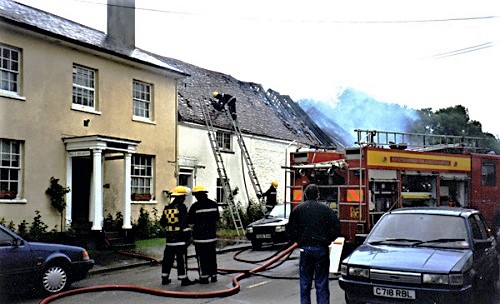
The fire started in the barn at the corner of High Street and Edwards Hill, it spread almost immediately to the adjoining cottage, number 34. Had it not been for the prompt action of the local Fire Brigade, the next building in the row “The Downs House”, would also have gone up in smoke.
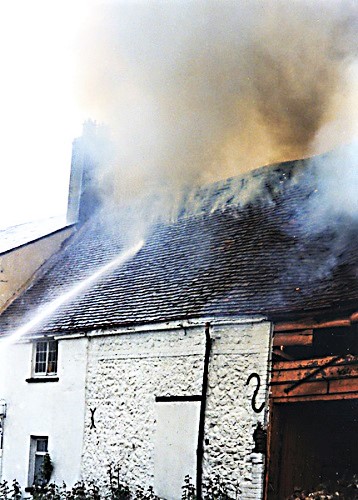
I watched the firemen breaking through the tiled roof of the cottage so as to get a hose into the roof space to prevent the flames spreading to next doors attic. It was touch and go but with reinforcements arriving very quickly the firemen managed to save Mrs. Warr’s Guest House. Fire Tenders arrived from Wantage, Didcot, Hungerford and goodness knows from where else.
The barn and cottage were gutted. As was Alistair Paton the owner.
The fire was started accidentally by the builders who were converting the old barn to a dwelling.
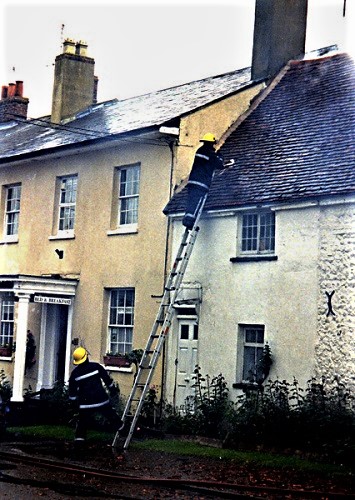
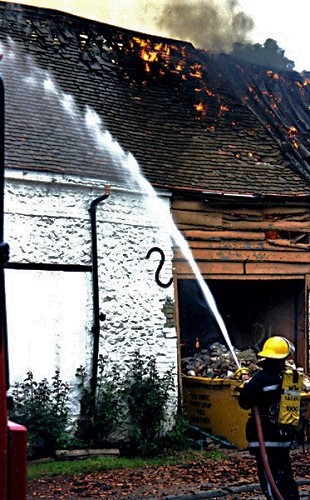

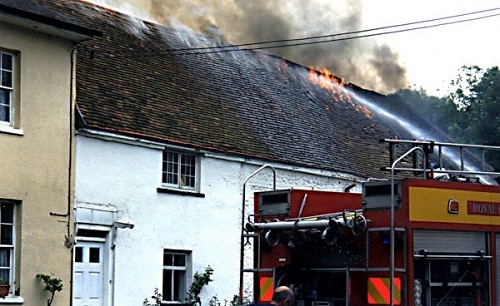
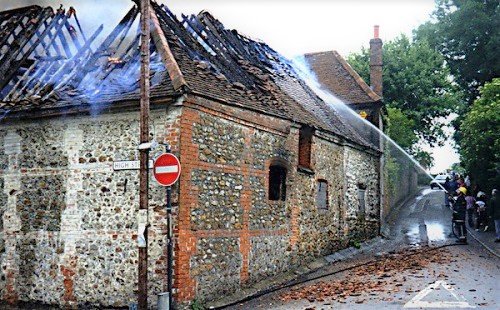
1980’s Baydon House
By Neil Robertson
Another fire in the High Street but this one was in the early 1980’s
Baydon House went up in smoke while the owners, Mr & Mrs Thatcher were away. It’s a mystery how the fire started but a blessing no one was injured.
My wife and I were next to occupy Baydon House, we lived there for ten years from 1990. We have very happy memories of our time there.
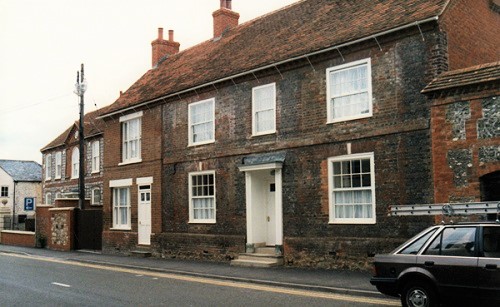

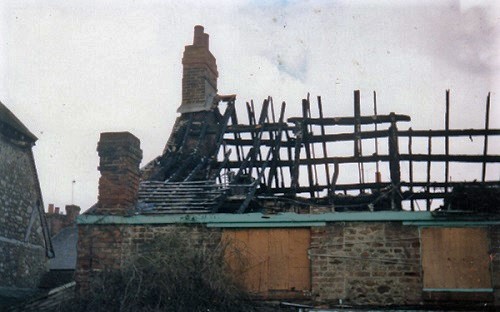
Rear of house.
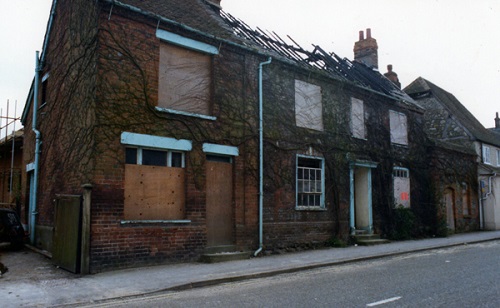
Front of Baydon House awaiting Planning.

Left some time before restoration began
1939 – Stable Blaze at Seven Barrows – 4 horses dead
Transcribed by Liz Beard
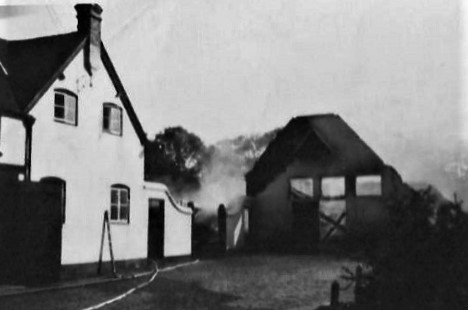
The neighing and stamping of terrified horse was the first warning of a fire which caused damage amounting to several thousand of pounds at the Seven Barrows, Lambourn, stables of Mr H.L.Cottrill, the well-known trainer, on Sunday afternoon of the 9th June 1939
Four valuable racehorses were burned to death and a building containing 50 boxes and a costly violet-ray plant was completely destroyed. So rapid did the flames spread that rescuers were unable to get anywhere near the boxes in which the four horse perished and only just succeeded in releasing the remaining animals. They had no time to halter them, but turned them loose in the paddock where some of the horses stampeded and broke away on to the Downs.
Flames Sweep Through Thatch
The four horses burned to death were Brave Warrior, a five year old, bought for £750 after winning at Epsom a fortnight ago. Deep Level, a four-year-old gelding belonging to Sir Abe Bailey, Slip On, a four year old, and Bizou, a three year old, owned by Captain Lionel Montague.
Fifty other horses, some of them entered for Ascot, were saved, including Fairstone, which ran in the Derby, Magic Circle, Golden Sovereign, Caerloptic and Dragonnade, which was engaged for the Newbury Cup this week.
The building which was destroyed, roughly formed three sides of a square and had a thatched roof with tiled eaves. One end consisted of a barn converted into stables with a hay and straw loft and adjoining this and close to Mr Cottrill’s house and the stable lad’s quarters were the violet-ray room and the battery and engine rooms.
The fire started at the north end of the building and in a few minutes the flames driven by a stiff breeze had raced along the thatch and spread to the other stables
Eye-Witness’s Stories
Graphic stories of the fire were told by eyewitnesses. Except for the apprentices, there were only a few lads on the premises at the time, and these were resting in their rooms before grooming the horses at 4.30.
Mr W Johnson, whose special charge is Fairstone said, “About 3.45 Mr Jimmy Wilde, one of the head lads, ran through my room shouting ‘Fire’ He had seen the flames from a window. We ran into the yard together. The place was full of smoke and the horses were whinnying and kicking their boxes.
“Our first concern was to save as many horses as we could. I brought out Golden Sovereign and then unloosened Fairstone and Caerloptic, turning them out into the paddock. Mr Wilde rescued Dawn Fox which was in the next box to Brave Warrior, Draggonnade, Valentine and Magic Circle followed. The rugs on the backs of some were burning and the animals were frantic with terror. When they were turned loose they bit and savaged each other and what with the fire and trying to control the horses it was a nightmare. I don’t want to go through another experience like it again”
Refused to Come Out
Jim Cane, the headman, and John Roberts, a new lad, made a gallant effort to rescue Brave Warrior. Roberts says he got a sack over the horse’s head but in its frenzy it kept going round and round in the blazing box and would not come out. In a second or two the burning roof fell in and they were forced to retreat. Roberts said he also opened Valentine’s door and the horse rushed out with it s rug blazing. It was burnt about the quarters.
Meanwhile Lambourn Brigade had been summoned and were on the scene five minutes later under Chief Officer JRB Cramsie, himself a trainer. They were followed by the Hungerford and Wantage Brigades and while Lambourn pumped from a pond in the paddock adjacent to the house, Wantage pumped from a pond on Lye Lease Down to a dam in the paddock where Hungerford picked up the supply.
In spite of the combined efforts of the three brigades the flames had secured such a firm hold of the thatched building that they could do little to check them. The stables were soon a blazing mass and it seemed a miracle that so many horses had been saved. The pond from which Lambourn brigade were pumping ran dry after about two hours and they then connected with the main hydrant. This had not been used before as the pressure was insufficient. The Hungerford and Wantage Brigades returned to their stations on Sunday night, but the Lambourn Brigade remained on duty until 7 o’clock Monday morning, a fresh relay of firemen coming on during the night.
Although the fireman found it impossible to save the main building they did splendid work in preventing the fire from spreading to the house and the stable lads quarters. At one time with the wind in that direction, it looked as though these would be involved and as a precaution the lads moved all their kit outside. In addition to the stables the violet-ray room and engine room were gutted, but the battery room was saved.
Mr Cottrill received the greatest help from his fellow trainers in Lambourn. Of the fifty horses which were rescued Mr Marcus Marsh accommodated 24 at his stables and the remainder were taken by Sir Hugh Nugent, Mr FB Stapleton Martin, Mr R Bennett and Mr CAV McVittie.
The horses have now been returned to Seven Barrows where Mr Cottrill had a number of unoccupied boxes. Yesterday (Wednesday) Mr Cottrill’s secretary stated that except for a few scratches the horses were none the worse for their experience and had all resumed normal exercise.
This is the second fire which has occurred at Mr Cottrill’s stables recently. About three weeks ago a straw store near where Sunday’s blaze started, caught alight and was put out by the Lambourn Brigade.
The cause of both outbreaks is unknown.
Mr HL Cottrill wishes to thank all those who so kindly helped at the fire which took place at Seven Barrows on Sunday last as it is quite impossible for Mr Cottrill personally to thank the many people who so very kindly assisted him.

Liz Beard 2008
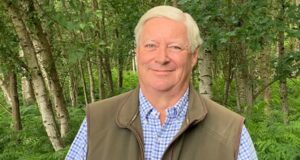
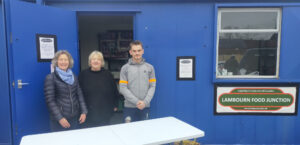


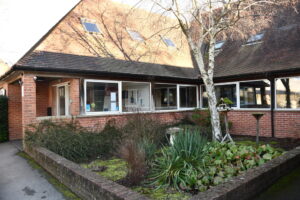
An earlier Fire “Reading Mercury – 28 January 1854 – Great Fire at Eastbury Near Lambourn. – On Saturday, the 21st instant, a fire broke out, about half-past six o’clock in the morning, in a stable at the Manor Farm, Eastbury in the occupation of Mr Liddiard and destroyed the same, with a shed, dwelling-house three cottages adjoining five horses, wagons etc. The fire also extended to the Plough Inn barn and stable adjoining, which were completely destroyed. From what we can learn, It appears that the carters went to the stable between five and six o’clock in the morning and cleaned and fed the horses, and between six and seven, while they were at breakfast, the stable was discovered to be on fire. Assistance was immediately rendered by the workmen and the inhabitants of the village, to check the progress of the devouring element, and to rescue the poor horses but without effect. The animals, it is supposed, must have been suffocated before the fire was discovered. Adjoining the stable was a large quantity of corn in a barn surrounded by many ricks, valued at several thousands of pounds, all of which would have been destroyed but for the strenuous exertions of Mr. Liddiard and his friends, who directed their efforts so as to confine the fire to the premises where it originated. Fortunately an abundance of water was obtained from the Lambourn River, which passes close to the premises, otherwise the whole of the property must have fallen prey to the devouring element. The fire is supposed to have been entirely accidental. We hear that the premises were insured in the Norwich Union, and the farming stock of Mr. Liddiard in the Imperial Fire Office. Too much cannot be said in commendation of the villagers and others of the neighbourhood, for their great exertions on the occasion; for, had not ready assistance been rendered, it is fearful to contemplate what the destruction of property might have been, considering the ignitable nature of the surrounding buildings.”
William didn’t appear to be fully covered by Insurance for the losses in the fire, but, his brother in law, being agent for the insurance company managed to get payment for full value of the loss. “Reading Mercury – 4 March 1854 – The Late Fire at Eastbury. – We have no doubt it will be in the recollection of our readers that there appeared in this Journal a report of a fire, which took place on the 28th January last, on the farm in the occupation of Mr Liddiard, and consumed a stable and other buildings, together with several valuable horses, harness and implements of husbandry; and through the strenuous exertions of Mr Liddiard and the villagers of the neighbourhood, a large quantity of corn in the barns adjoining and the ricks with which the premises were surrounded were saved. Mr L, who was insured in the Imperial Fire Office, informed the agent of what had occurred, and on referring to his policy, it was discovered it only affected the corn, hay and straw; though no doubt, Mr L when he insured believed that the words of the policy would include his live and dead stock. Mr Robert Darling of Speenhamland who is agent for this district, communicated with the Board of Directors, and detailed the circumstances and the loss sustained. The directors though not legally liable to the loss, no mention of live and dead stock having been mentioned in the policy, at once came forward most liberally, and directed Mr Darling to pay Mr Liddiard £143, the full amount of the valuation of his loss.”
e in Eastbury.